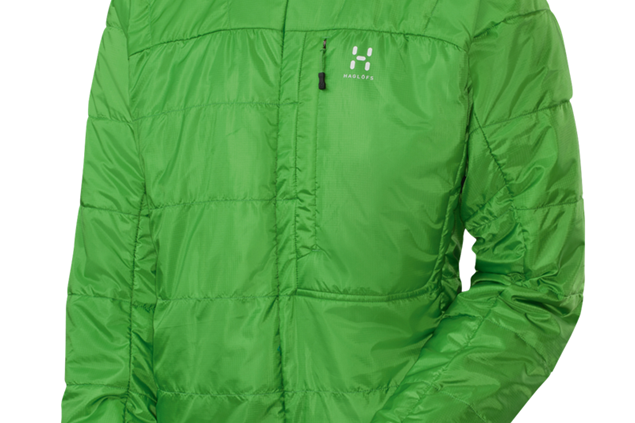New for this winter, Rab’s Vapour-Rise Guide Jacket is a winter weight version of the proven Vapour-Rise soft shell system with warmer zoned Polartec Hi Loft fleece on the inside and the highly breathable Pertex Equilibrium fabric outside.
Think of it as a more modern take on the classic pile-Pertex garments produced by Buffalo and you won’t go far wrong.
Tech Lowdown
Where Rab’s standard Vapour-Rise uses a very light micro-velour type liner, the winter-friendly Guide version has a lining of much warmer Polartec High Loft fleece. The idea is that the gridded pattern traps more air and gives a better warmth to weight and bulk ratio. It’s not quite that simple though, the lining is also zoned with a thinner area of standard VR liner on the back where your pack sits and down the inside of the sleeves to improve mobility and make the jacket easier to put on.
On the outside, Rab’s used Pertex Equilibrium fabric again. Equilibrium is the odd one out in the Pertex range, it’s not 100% windproof, but the pay-off is impressive breathability and wicking performance combined with decent wind and water resistance. A good compromise in other words. There are tougher, heavy duty panels over the shoulders for pack use too.
Performance
The Vapour Rise Guide is warm, very warm. That means it really is properly winter specific and because it’s a single unit, somewhat inflexible. That said, when it gets really cold, down below zero, it’s absolutely brilliant.
It has a lot of Buffalo and similar pile/Pertex combo pros without some of the downsides. So the jacket breathes and wicks impressively, dries fast and even keeps your dry in light to moderate rain and in snow.
It’s less bulky and inflexible feeling than most pile/Pertex garments which suffer from the bulkkiness of the pile and very basic design and cut and doesn’t feel remotely restrictive. It’s also significantly more breathable in our opinion, thanks to the Equilibrium fabric.
That is a two-way sword though, in really strong winds, you can feel a little bit of icy penetration through the fabric, though it was never a major problem for us.
Cut is a sort of medium. You could probably, in really cold conditions, layer a microfleece underneath, but for most active use we found the jacket on its own more than warm enough and the pit-zips and main opening got a fair bit of use on more sustained ascents.
That built-in warmth is a bit of an issue for some, in that it limits the jacket’s versatility. There’s a sort of heat limit above which you can’t really use the Guide and its relatively high weight and bulk mean you don’t really want to carry it around with you either, so it’s very much a ‘put on at the start of the day and take off at the end’ sort of garment.
What else? Well, you can lose your hat happily knowing that the fleece-lined, fully-adjustable, wired-peak hood will play a blinder as sub’ and take a helmet too. There are three decent-sized pockets for hand-warming and storage. Cuffs and hem are adjustable and the sleeves will roll up over our forearms for some additional venting.
Verdict
For pure, extreme cold conditions, winter use, the Vapour-Rise guide is a knock-out. It’s warm and comfortable with a nice, soft feel to it, has decent mobility and handles moisture from inside and out really well. It has a lot of pile/Pertex attributes, but with fewer of the downsides and its forte is damp, cold, British mountain weather.
However, like pile/Pertex, it’s a little too warm when temperatures rise much above freezing levels which makes it a little inflexible compared to thinner soft shells which can be layered according to conditions.
But if what you need is a winter-specific soft shell for all-round mountain use, we reckon the combination of features, performance and decent price makes it a bit of a bargain.
Pros
Warm, breathable, well-specced, weather resistant and good in typically damp UK conditions with excellent overall comfort.
Cons
A little weighty, not 100% windproof, needs to be properly cold for it to really work well and it won’t suit everyone.


